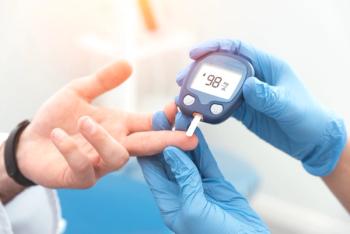
- Consultant for Pediatricians Vol 9 No 8
- Volume 9
- Issue 8
Boy With Exercise-Related Exhaustion, Hypertrophic Calf Muscles, and Thigh Muscle Wasting
Otherwise healthy 9-year-old African American boy seen for first time for complaints of frequent exhaustion, particularly when climbing stairs or walking for long periods. He could no longer participate in sports because of inability to keep up with his peers. He had been toe walking and had become clumsier over the past year, tripping and falling more frequently. Besides a mild delay in walking (around 16 months), his mother had reported no outstanding gross motor delays in infancy. He was in a regular class in school, although he did receive extra help in math and reading.
HISTORY
Otherwise healthy 9-year-old African American boy seen for first time for complaints of frequent exhaustion, particularly when climbing stairs or walking for long periods. He could no longer participate in sports because of inability to keep up with his peers. He had been toe walking and had become clumsier over the past year, tripping and falling more frequently. Besides a mild delay in walking (around 16 months), his mother had reported no outstanding gross motor delays in infancy. He was in a regular class in school, although he did receive extra help in math and reading.
PHYSICAL EXAMINATION
He had hypertrophic calf muscles and significant thigh muscle wasting. Gait was abnormal and unsteady, with mild weakness noted bilaterally in the lower extremities. Deep tendon reflexes were normal, and cranial nerves II through XII were intact. The remainder of the physical findings were unremarkable.
LABORATORY FINDINGS
Blood tests revealed an extremely elevated creatine phosphokinase (CPK) level (17,863 IU/L [normal, less than 160 IU/L]) and elevated liver transaminase levels (aspartate aminotransferase [AST], 382 U/L; and alanine aminotransferase [ALT], 682 U/L).
"WHAT'S YOUR DIAGNOSIS?"
ANSWER: DUCHENNE MUSCULAR DYSTROPHY
Resources for Parents of Children With Newly Diagnosed Duchenne Muscular Dystrophy The following Web sites provide a wealth of information on Duchenne muscular dystrophy (DMD) and many resources for parents of children with DMD:
The examination and laboratory findings raised suspicion for Duchenne muscular dystrophy (DMD). The mother and young boy were counseled about this concern (
INCIDENCE AND PATHOPHYSIOLOGY
DMD is the most common hereditary neuromuscular disease in boys, affecting about 1 in 3600 live-birth males. Because DMD is an X-linked recessive disorder, it is rare in girls. DMD is caused by a defect in the dystrophin gene, which codes for a protein that plays a crucial role in muscle function and maintenance. It has been suggested that this defect makes the dystrophinassociated protein complex unable to bind, resulting in unstable plasma membranes that are then damaged through continued muscle contractions; the instability of the plasma membranes can lead to loss of calcium homeostasis and cell death.1 Ultimately, this defect in the dystrophin gene leads to insidious muscle fiber degeneration throughout the first 2 decades of life. Because dystrophin is present in cardiac muscle and in the brain, as well as in skeletal muscle, DMD is characterized not only by muscle weakness but frequently by cardiomyopathy and intellectual impairment as well.
CLINICAL MANIFESTATIONS
The first symptoms of DMD do not generally appear until age 2 to 3 years; most gross motor skill milestones are reached at appropriate ages or with only a mild delay. Proximal muscle weakness is typically seen in the lower extremities before it appears in the upper extremities. The first signs of the disease are usually hip girdle weakness and Gower sign; the latter may be seen as early as age 3 years. Affected children assume a lordotic posture and walk with a hip waddle, or Trendelenburg gait, in order to compensate for gluteal weakness. These signs of more progressed disease tend to appear by age 5 to 6 years. By age 6, most patients have enlarged calf, gluteal, and deltoid muscles (pseudohypertrophy), along with noticeable weakness; the most severe weakness is usually located in the proximal and lower extremities. Patients may also experience contractures in the ankles, knees, hips, and elbows. Duration of ambulation varies and can be prolonged with orthotic devices and therapy; however, most patients are confined to a wheelchair by age 12 years. Scoliosis is also a common problem, and it tends to worsen once a child is no longer ambulatory.2
Lung restriction secondary to scoliosis, together with weakening respiratory muscles, can progress to respiratory failure. Patients should be closely monitored for signs of disordered sleep and obstructive sleep apnea. In addition, prolonged colds or coughs need to be managed aggressively to maintain good respiratory function. Because 10% to 20% of patients with DMD succumb to cardiac failure resulting from cardiomyopathy, yearly cardiac examinations should be performed.3
DIAGNOSIS
Diagnosis is usually made on the basis of elevated serum CPK levels and a positive result on a blood PCR DNA probe for the most common dystrophin gene mutations. The dystrophin gene is one of the largest genes in the human genome; the PCR DNA probe searches for a variety of mutations, including deletions, insertions, and duplications along a large area of the dystrophin gene.4 However, if the probe does not definitively diagnose DMD, a muscle biopsy may be needed so that muscle tissue can be evaluated for abnormal or absent dystrophin by immunological or protein analysis.5 Muscle biopsy in a patient with DMD typically shows necrotic, degenerating muscle fibers surrounded by macrophages and CD4+ lymphocytes as well as regenerating fibers from myoblasts.1
This boy had fairly mild symptoms for his age: minimal hip waddle, mild gait disturbance, and only a slight learning disability. His elevated transaminase levels were not the result of liver disease but of muscle breakdown. Several case reports provide a clinical pearl that when the ALT level is significantly greater than the AST level and there is no evidence of liver disease, DMD in its early stages should be considered.6 Although this patient was receiving tutoring, he had no clearly defined cognitive disturbances, no heart disease (cardiomyopathy) on echocardiogram, and no skeletal abnormalities or scoliosis on his current examination. His symptoms also seemed to manifest later than in most patients with DMD. This last fact raised the question of whether the child had Becker muscular dystrophy, a type of muscular dystrophy that is very similar to DMD but that follows a milder and more prolonged course.2 However, results of his DNA probe-as well as the results of probes from family members-revealed that he had DMD with a deletion mutation responsible for dystrophin-associated protein attachment.
MANAGEMENT AND PROGNOSIS
No drugs are currently approved for the treatment of DMD. Prednisone has proven benefit in DMD and is usually started at a dosage of 0.75 mg/kg/d. However, the long-term effects of daily corticosteroids have led to the consideration of different dosing schedules. In addition, there has been controversy regarding when to start and when to stop corticosteroid therapy in a child with DMD. Most physicians will not start corticosteroid therapy if a child is still making progress or getting stronger, even if genetic testing is positive. However, if a patient has reached a plateau in his or her strength level or is weakening, corticosteroid therapy is indicated. Corticosteroids have been shown to prolong ambulation, which, in turn, maintains muscle mass, bone density, and social interaction.7 Long-term corticosteroid therapy along with an angiotensin-converting enzyme inhibitor has been shown to preserve cardiac function.8
Physical therapy is also an important part of therapy for children with DMD. Only 10 years ago, some children with DMD were told not to exercise to preserve muscle function. We now know this is wrong; refraining from exercise leads to contractures and to earlier onset of weakness and limited mobility. Daily stretching is recommended, but lifting weights is discouraged. Orthotic devices and braces can be used to reduce contractures. As the disease progresses, consultation with a pulmonologist can be useful for consideration of noninvasive ventilation and cough-assist devices.
Data on new potential therapies for DMD have recently been published.9,10 Although still only in the animal model stage, these therapies-which involve modification of gene and protein expression-appear promising. Other experimental therapies use drugs to block myostatin, which is a negative regulator of muscle growth. These therapies facilitate muscle regeneration and growth and reduce muscle fibrosis.11
Currently, the overall prognosis for patients with DMD is not particularly good; most die of either cardiac or respiratory complications by early adulthood. However, life expectancy has been steadily increasing, and because there are newer therapies in the pipeline, it is important for patients to be closely monitored by a multidisciplinary team that includes a cardiologist, a pulmonologist, a physical therapist, a nutritionist, an orthopedic surgeon, a mental health specialist, a sleep medicine specialist, and a primary care physician.3 Patients should receive regular immunizations, along with a yearly influenza vaccine and a pneumococcal vaccine every 5 years.
References:
REFERENCES:
1.
Deconinck N, Dan B. Pathophysiology of Duchenne muscular dystrophy: current hypotheses.
Pediatr Neurol
. 2007;36:1-7.
2.
Bigger WD, Klamut HJ, Demacio PC, et al. Duchenne muscular dystrophy: current knowledge, treatment, and future prospects.
Clin Orthop Relat Res
. 2002;401:88-106.
3.
Finder JD, Birnkrant D, Carl J, et al; American Thoracic Society. Respiratory care of the patient with Duchenne muscular dystrophy: ATS consensus statement.
Am J Respir Crit Care Med
. 2004;170:456-465.
4.
Takeshima Y, Yagi M, Okizuka Y, et al. Mutation spectrum of the dystrophin gene in 442 Duchenne/Becker muscular dystrophy cases from one Japanese referral center.
J Hum Genet
. 2010;55:379-388.
5.
Cohn RD, Campbell KP. Molecular basis of muscular dystrophies.
Muscle Nerve
. 2000;23:1456-1471.
6.
Zamora S, Adams C, Butzner JD, et al. Elevated aminotransferase activity as an indication of muscular dystrophy: case reports and review of the literature.
Can J Gastroenterol
. 1996;10:389-393.
7.
Balaban B, Matthews DJ, Clayton GH, Carry T. Corticosteroid treatment and functional improvement in Duchenne muscular dystrophy: long-term effect.
Am J Phys Med Rehabil
. 2005;84:843-850.
8.
Ogata H, Ishikawa Y, Ishikawa Y, Minami R. Beneficial effects of beta-blockers and angiotensin-converting enzyme inhibitors in Duchenne muscular dystrophy.
J Cardiol
. 2009;53:72-78.
9.
Yokota T, Lu QL, Partridge T, et al. Efficacy of systemic morpholino exonskipping in Duchenne dystrophy dogs.
Ann Neurol
. 2009;65:667-676.
10.
Odom GL, Gregorevic P, Chamberlain JS. Viral-mediated gene therapy for the muscular dystrophies: successes, limitations and recent advances.
Biochim Biophys Acta
. 2007;1772:243-262.
11.
Wagner KR, Fleckenstein JL, Amato AA, et al. A phase I/II trial of MYO-029 in adult subjects with muscular dystrophy.
Ann Neurol
. 2008;63:561-571.
Articles in this issue
about 15 years ago
Henoch-Schönlein purpura with gastric wall thickeningabout 15 years ago
Graves Diseaseabout 15 years ago
What Is This Annular Rash?about 15 years ago
Boy With Multifaceted Acute Illnessabout 15 years ago
A Collage of Genital Lesions, Part 3about 15 years ago
My Experience Practicing Disaster-Relief Pediatrics in HaitiNewsletter
Access practical, evidence-based guidance to support better care for our youngest patients. Join our email list for the latest clinical updates.














